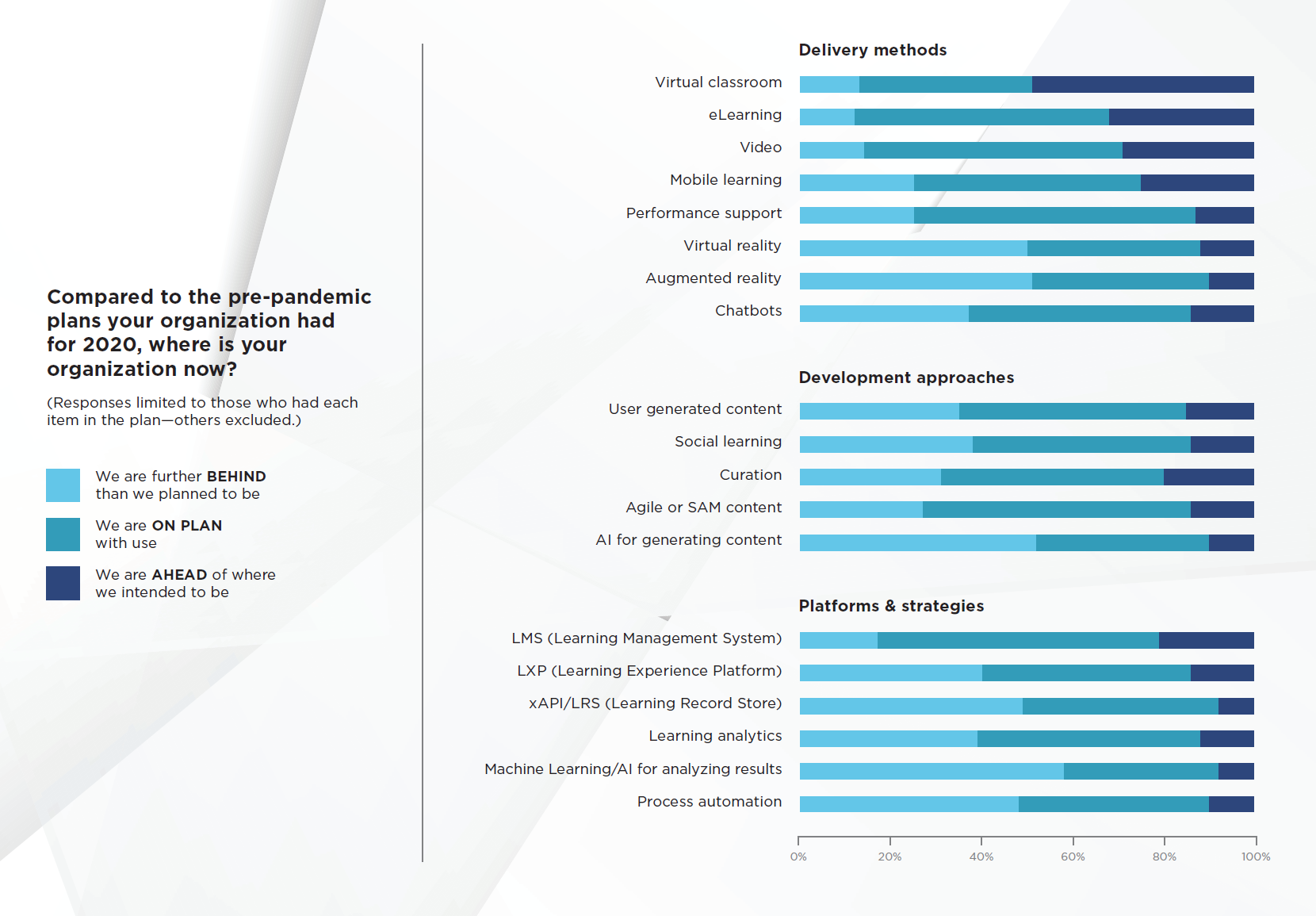By now it’s not new news that the pandemic put big plans—both personal and professional—on pause. After numerous studies—and our collective experiences—confirmed that nearly all face-to-face learning moved to the virtual classroom in 2020, we wanted to explore the greater impact of pandemic on long-range learning technology roadmaps. The Learning Guild conducted a survey in January and February of 2021, compiling insights from over 1,100 L&D practitioners, and we uncovered three key findings.
1. Catching up with technology, not leaping ahead
Our hypothesis, based on anecdotal evidence, was that organizations would be leapfrogging their technology roadmaps, taking on once-future initiatives now that they had an urgent reason for change. Instead, we found that organizations that were lagging in their learning technology adoption finally had a compelling organizational need to catch up. In these cases, there were few established technologies and a great need to move fast. At the same time, many organizations that were ready to take on big initiatives like learning experience platforms, xAPI, virtual reality, augmented reality, and artificial intelligence put those plans on pause. These are the organizations that likely already had established learning technologies and little appetite in an uncertain environment to take on something new.
 Fig 1: More professionals report being behind their plans for technology adoption than report being ahead
Fig 1: More professionals report being behind their plans for technology adoption than report being ahead
This is consistent with other surveys, including Donald Taylor’s annual L&D Global Sentiment Survey (open through December, 2020 and January, 2021). When he asked, “What will be hot in L&D in 2021?”, respondents tended to cite traditional technologies such as coaching, performance support, and mobile. More “aspirational” technologies such as LXPs, virtual reality, and augmented reality suffered. Don’s take on this: “… in times of crisis people move to the familiar.”
2. Doing more, and doing it faster
Consistent in our research was a sense that the pace of work was accelerating. Not only did organizations need more and faster delivery from L&D teams as situations changed rapidly, but organizations found that the minimum viable products were often sufficient to meet the need. This is not surprising given the sheer amount of change that L&D teams took on. 55% told us they offered training in 2020 that wasn’t offered widely in 2019. 41% used new instructional strategies to meet the needs. 38% used new content creation strategies and 32% used new technology platforms.
 Fig. 2: L&D professionals offered new content, new instructional strategies, new content creation technologies, and new platforms that were not in use in 2019
Fig. 2: L&D professionals offered new content, new instructional strategies, new content creation technologies, and new platforms that were not in use in 2019
Jessica Manning of Paycor summed it up this way: “In a virtual environment, we’re moving faster than we have before. Where we may have defaulted to an instructor-led training in the past, we’re doing more with videos and recorded content. To keep pace, we re-evaluated the quality of our deliverables. We’re now focused on fast, efficient, just-in-time training where in the past we would have taken more time to develop a higher quality deliverable.”
3. Proving our value, but still an uphill climb
And finally, the pandemic provided L&D practitioners an opportunity to prove their value to their organizations. As Carrie McMann of The Co-operators put it, “My calendar blew up: from not being at the table to attending everyone’s table to identify opportunities to collaborate.”
This newfound stature may be experienced differently from organization to organization. Nearly half of respondents said that the pandemic accelerated their ability to make plans for the future. This is an interesting result given how much we’ve seen that their plans for 2020 changed. It may be indicative of a confidence that a move to digital delivery platforms will be a more resilient and future-ready approach for the coming years.
Most (70%) report that the pandemic has either not had an impact on their ability to hire the right people or has accelerated it. This may be a result of increased work-from-home options and the ability to open up job markets that span traditional geographic boundaries.
On the other hand, only 20% responded that the pandemic has accelerated their ability to secure budget for L&D initiatives, with twice as many saying that it has hampered their ability to secure budget.
 Fig 3: The pandemic has impacted L&D’s ability to make plans, hire and secure budgets
Fig 3: The pandemic has impacted L&D’s ability to make plans, hire and secure budgets
What’s next?
The Learning Guild’s research report concludes with case studies of resilience and innovation as organizations adapted to the challenges to working and learning that posed by the pandemic.
For more information, don’t miss The Learning Guild’s April research report, Effects of the Pandemic on Learning Technology Roadmaps.
Not a member? No problem! Sign up here.



